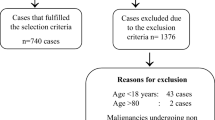Abstract
Introduction
Patients undergoing major breast surgery have an almost negligible need for blood transfusions. However, type and screen requests are still routinely performed. This represents an inefficient utilization of resources and unnecessary workload for laboratory staff. The aim of this study was to ascertain whether pre-operative blood typing is justified in patients undergoing surgical procedures with an intermediate transfusion probability.
Methods
A retrospective analysis of all patients undergoing a mastectomy and axillary clearance, with or without breast reconstruction in the last 2 years was undertaken. The number of group and hold and cross-match samples that were performed were identified and compared to the number of patients requiring a blood transfusion. The overall cost of routine pre-operative blood typing was analysed.
Results
A total of 229 patients were identified. Of these, a group and hold was performed on 192 (83.8%) patients. Cross-matching was undertaken in thirty-one patients (13.5%). In total, five patients (2.1%) required transfusion. No patient was transfused intra-operatively. The overall cost of routine group and hold blood requests was 1,920 euros and of pre-operative cross-matching was 465 euros. Forty-seven units of blood was returned unused to the blood transfusion service at an estimated cost of 23,500 euros.
Conclusion
The need for routine group and hold blood requests is not justified for patients undergoing elective breast surgery and represents a waste of clinical resources. A more targeted approach will not only reduce the demand on blood products but also reduce the associated costs to blood transfusion services.
Similar content being viewed by others
References
Roizen MF (2000) Preoperative evaluation. In: Miller RD (ed) Anaesthesia. Churchill Livingston, New York, pp 824–883
Lowery T, Clark J (1989) Successful implementation of maximum blood order schedule. J Med Assoc GA 78:155–158
Richardson N, Bradely W, Donaldson D et al (1998) Maximum surgical blood ordering schedule in a district general hospital saves money and resources. Ann R Coll Surg Engl 80:262–265
Atrah HI, Gaea G, Urbanaik SJ (1995) The sustained impact of a group and screen and maximum surgical blood ordering schedule policy on the transfusion practice in gynaecology and obstetrics. Clin Lab Haematol 17:177–181
Rehm JP, Otto PS, West WW et al (1998) Hospital wide education program decreases red blood cell transfusions. J Surg Res 75:183–186
Van Klei WA, Moons KGM, Rheineck Leyssius AT et al (2001) A reduction in type and screen: preoperative prediction of RBC transfusions in surgery procedures with intermediate transfusion risks. Br J Anaesth 87(2):250–257
Van Klei WA, Moons KGM, Rheineck Leyssius AT et al (2002) Validation of a clinical prediction rule to reduce preoperative type and screen procedures. Br J Anaesth 89(2):221–225
Mead JH, Anthony CD, Sattler M (1980) Hemotherapy in elective surgery: an incidence report, review of the literature and alternatives for guideline appraisal. Am J Clin Pathol 74:223–227
Lin JS, Chen YJ, Tzeng CH et al (2006) Revisiting of preoperative blood ordering policy—a single institute’s experience in Taiwan. J Chin Med Assoc 69:507–511
Foley CL, Mould T, Kennedy JE et al (2003) A study of blood cross-matching requirements for surgery in gynaecological oncology: improved efficiency and cost-saving. Int J Gynecol Cancer 13:889–893
Sharma S, Cooper H, Ivory JP (2002) An audit on the blood transfusion requirements for revision hip arthroplasty. Ann R Coll Surg Engl 84:269–272
Rogers BA, Johnstone DJ (2006) Audit on the efficient use of cross-matched blood in elective total hip and total knee replacement. Ann R Coll Surg Engl 88:199–201
Palmer T, Wahr JA, O’Reilly M et al (2003) Reducing unnecessary cross-matching: a patient-specific blood ordering system is more accurate in predicting who will receive a blood transfusion than the maximum blood ordering system. Anesth Analg 96:369–375
Dhariwal DK, Gibbons AJ, Kittur MA et al (2004) Blood transfusion requirements in bimaxillary osteotomies. Br J Oral Maxillofac Surg 42:231–235
Ness PM, Rosche ME, Barrasso C et al (1981) The efficacy of type and screen to reduce unnecessary cross-matched for obstetric patients. Am J Obstet Gynecol 140:661–664
Chin-Yee I, Arya N, D’Almeida MS (1997) The red cell storage lesion and its implication for transfusion. Transfus Sci 18:447–458
Author information
Authors and Affiliations
Corresponding author
Rights and permissions
About this article
Cite this article
Prichard, R.S., O’Keefe, M., McLaughlin, R. et al. A study of pre-operative type and screen in breast surgery: improved efficiency and cost saving. Ir J Med Sci 180, 513–516 (2011). https://doi.org/10.1007/s11845-010-0668-y
Received:
Accepted:
Published:
Issue Date:
DOI: https://doi.org/10.1007/s11845-010-0668-y




